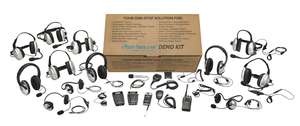

|
Edward Lowton
Editor |


|
| Home> | Health, Safety & Welfare | >Plant and machinery safety | >Hands-free communication and your workplace safety plan |
Hands-free communication and your workplace safety plan
30 September 2022
Hands-free communication can play an important role in reducing workplace distractions, but integrating it as part of a workplace safety plan involves investing in the right equipment and training staff on how to use it, says Rick Farrell

It is common sense that the less distracted you or one of your co-workers or employees are while on the job, the less likely they will make a mistake. That is particularly true in work environments with machinery, moving parts, dangerous equipment, or materials, but it applies to any work environment, even in a wireless tour guide system.
There are many steps you can take to reduce distractions. One of the most important is to streamline communications systems, processes, and equipment and make it as hands-free as possible.
If you must take the time to answer and hold a phone or other communications device, it requires your attention and your focus. Even if that happens in a millisecond, it is one millisecond you are not focused on your immediate work or work environment.
Driving is the obvious example, but there are many other scenarios where fewer distractions mean less risk of injury:
- Equipment with a lot of moving parts
- Equipment with deadly components (electricity, blades, etc.)
- Mission-critical duties
- Sites with heavy machinery
- Sites where extreme noise is present
And these are just a few examples. Virtually every type of work outside of an office environment has any of these or a combination of these every day. On a construction site, for instance, all could apply at the same time. In that environment, hands-free communication is key to ensuring important messages and alerts get quickly and accurately delivered.
Streamlined work processes
Whether you use cell technology or handheld radios, a properly set up hands-free communication system improves workflow and increases safety. For example, avoiding a piece of equipment because it is in operation is much easier to relay via a lighting system or signage than having an employee warn everyone around individually.
Additionally, being able to alert an entire site crew of specific operations quickly makes the work process easier and puts employees on notice when those operations are about to be or are executed.
A manager could alert people of the need to employ noise protection because of work activity in one fell swoop with a mass communications system versus relying on word of mouth individually or with the work unit's supervisors.
Improving focus
More focus is the opposite of fewer distractions but is an important benefit of hands-free communications in and of itself. If an employee constantly has to stop and physically activate a radio or phone, they are spending less time focused on the work you want them to do. Hands-free lets them put their full focus on the task at hand.
An assembly line employee that has to stop what they are doing to answer a phone call or talk to another employee must find their place and restart their work once they receive the message. Likewise, a construction worker performing precision work interrupted by a foreman or fellow employee must refocus once the interruption has ceased.
More accurate messages
If you have ever watched children play the game Telephone or played it yourself, you understand how stories can change with each iteration. When hands-free communication processes get used, the chances of that initial message becoming distorted become much less of a risk.
Not only do employees receive the same message, but the interpretation of the message is also more accurate. It is easy to misinterpret work instructions when they are relayed individually, via phone, versus when messages get relayed across your workplace simultaneously.
Accurate instruction interpretation is important no matter the task but could be life-saving if the alert is related to a safety issue.
Quicker responses
Hands-free communications processes also allow for quicker responses from employees. In a work environment dependent on verifying that employees are safe, such as when operating heavy equipment, hands-free speeds response time up and reduces the time an injury could occur.
Having to physically respond to verify you are out of harm's way wastes time, distracts you, and prolongs the danger period if you miss the message. Being able to reply quickly and without using your hands lets you focus on your work and verify that you are not in danger if your fellow employee does their work.
Faster mission critical responses
Quicker responses are particularly important when the situation is mission-critical. Instances that would apply in that scenario include, but are not limited to:
- Having to vacate a premises
- Clearing an area for a dangerous work activity like using explosives
- Evacuating under a threat
- Coordinating the responses of work parties that are engaged
Being able to respond hands-free in any of those environments lets you communicate without distracting employees or wasting time. Being able to relay a message instantly to critical personnel without having to speak to them personally or pick up a phone or activate an intercom system can save critical seconds and allow for more effective communications.
Increasing productivity
When an employee must pick up a phone or walk to an office, even give a hand signal, it distracts them, breaks up an existing work process, and prevents them from producing anything while responding. If that means a widget does not get produced according to an assembly line quota, it is one thing.
If, however, it means a fireman or medical personnel cannot perform their duties, an unsafe environment could escalate, or a patient's wellbeing could be put in jeopardy. On a less critical note, in-person or phone communications on a factory floor can stop an assembly line and prevent employees from completing more work.
Done once, with one employee. It is no big deal. Done multiple times with dozens of employees, the accrued labor time plus the lack of production can add up. Hands-free lets employees work while responding to messages or alerts.
Integrating hands-free into your workplace safety plan
Including hands-free as part of a workplace safety plan involves more than just covering it in a manual. It involves purchasing the necessary equipment and, as importantly, training staff on how to use it.
Additionally, new hands-free systems must be tested, employed, and adherence strongly encouraged, or the implementation will fall short of its goals.
Including it as part of a workplace safety plan puts teeth behind the implementation. Merely instructing employees to use a new alert lighting system, for instance, may get a few that always use it, most that use it sometimes, and a few that never use it. Mandating its use via a safety plan makes its implementation and utilization a work duty, which will increase participation.
Final thoughts
Hands-free communication is vital in today's work environment, especially if moving parts, machinery, or heavy equipment are involved.
Being able to coordinate alerts, whether to ensure site safety, utilize a wireless tour guide system or relay a mission-critical message, helps employees avoid injury or worse. It also lets your employees or co-workers focus on their jobs or a specific task instead of having to receive and respond to a message physically.
Rick Farrell is president of Plant-Tours.com
For more information:
Tel: +1 866 739 2575
- Earn CPD points by reading IP&E
- Cooling support
- Fast tracking vocational up skilling
- FIA & Western Business Media sign strategic agreement
- Enhanced robot vision system helps sort, pick and place
- New West Midlands Festival offers manufacturers direct access to future talent
- One million logistics robot shipments predicted by 2022
- Designing commercial photovoltaic installations for the long term
- thuba spotlights explosionproof emergency stop device
- Global demand for filters to reach $80bn by 2018




















